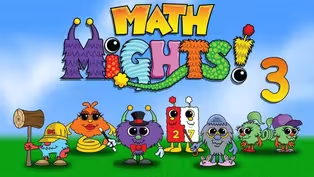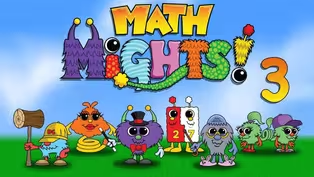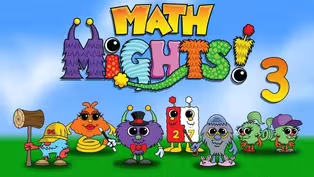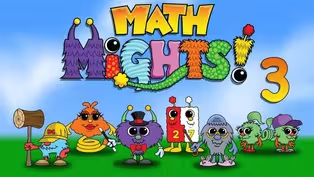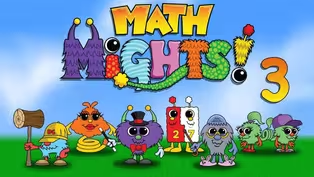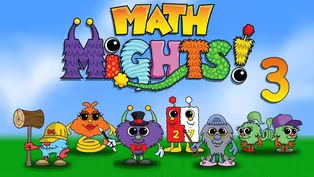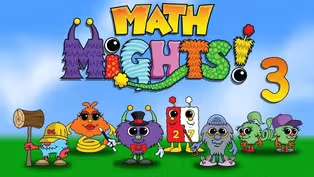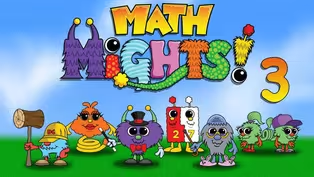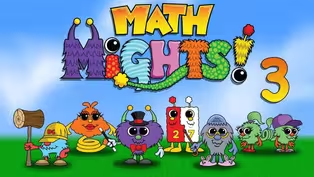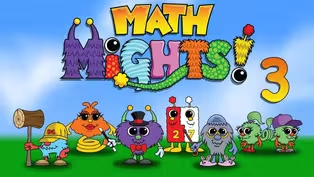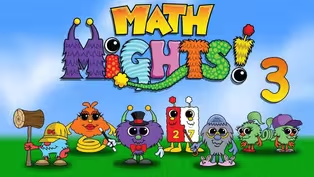Math Mights
Multiply with larger numbers
Season 3 Episode 302 | 16mVideo has Closed Captions
Learn about multiplying numbers larger than 20.
Join Ms. Askew to talk about numbers with her Math Mights friends. Next, she is going to help you take multiplication to a whole new level as we multiply numbers larger than 20!
Problems playing video? | Closed Captioning Feedback
Problems playing video? | Closed Captioning Feedback
Math Mights is a local public television program presented by Detroit PBS
Math Mights
Multiply with larger numbers
Season 3 Episode 302 | 16mVideo has Closed Captions
Join Ms. Askew to talk about numbers with her Math Mights friends. Next, she is going to help you take multiplication to a whole new level as we multiply numbers larger than 20!
Problems playing video? | Closed Captioning Feedback
How to Watch Math Mights
Math Mights is available to stream on pbs.org and the free PBS App, available on iPhone, Apple TV, Android TV, Android smartphones, Amazon Fire TV, Amazon Fire Tablet, Roku, Samsung Smart TV, and Vizio.
Providing Support for PBS.org
Learn Moreabout PBS online sponsorshipMore from This Collection
Video has Closed Captions
Join Ms. Askew for a tricky multi-step word problem with Professor Barble! (15m 59s)
Build Fraction from Unit Fractions
Video has Closed Captions
Join Ms. Askew for another multi-step word problem with Professor Barble! (15m 59s)
Video has Closed Captions
Join Ms. Askew for a division word problem with her friend Professor Barble. (15m 59s)
Video has Closed Captions
Join Ms. Askew for a division word problem with her friend Professor Barble. (16m)
Video has Closed Captions
Join Ms. Askew and Professor Barble to do a visual model with a word problem. (15m 59s)
Dividing with even larger numbers
Video has Closed Captions
Join Ms. Askew and Professor Barble to do a visual model with multiplication. (15m 59s)
Video has Closed Captions
Join Ms. Askew and Professor Barble to see if you can match visual models to word problems (15m 59s)
Dividing with Larger Quotients
Video has Closed Captions
Join Ms. Askew and Professor Barble to see if you can match visual models to word problems (15m 59s)
Video has Closed Captions
Learn about multiplying one-digit whole numbers by multiples of 10. (15m 59s)
Video has Closed Captions
Join Mrs. Askew for a Number Talk with 2 Math Might Friends! (16m)
Multiply Teen Numbers with Larger Groups
Video has Closed Captions
Join Mrs. Askew for a Number talk with 2 Math Might Friends! (15m 59s)
Relating Multiplication and Division
Video has Closed Captions
Join Ms. Askew for a subtraction number talk with Springling! (16m)
Providing Support for PBS.org
Learn Moreabout PBS online sponsorship(upbeat music) - [Kids] Math Mights!
- Welcome, third grade Math Might friends.
I'm so excited that you joined us today.
My name is Ms. Askew and I can't wait to have fun with you learning about math.
Let's check out our plan for today.
First, we're gonna do a subtraction number talk with some of our Math Might friends.
After our number talk, we're gonna learn how to multiply with larger numbers.
Let's warm up our brains with a number talk.
You might be asking yourself, what is a number talk?
Well, there are some steps that we have to take when doing a number talk.
Let's take a look at those steps.
Step number one, pose a problem using an operation that's familiar to you.
Step two, try to solve the problem mentally.
That means solving the problem in your mind without using paper or pencil.
And finally, step three, share out how you solved the problem, explaining your strategy.
Let's see, who's gonna help us with our number talk today.
It looks like our friends Springling and D.C. will be helping us.
And we may even get a visit from our math friend T-Pops.
Now remember, Springling likes to take big friendly number hops on an open number line and D.C., well, he likes to decompose numbers so that he can rename them and make subtracting easier.
Let's see what problem Springling and D.C. would like us to solve today.
94 minus 46.
Hmm.
What are some of the ways that you would think about solving that subtraction problem?
Let's see how Dante used Springling to help solve the problem.
94 minus 46.
Dante started at 46 and took a friendly number hop to the number 50.
Let's use our whiteboard to see how Dante used Springling to help him solve the problem.
Dante started at the number 46 and he wanted to stop at the number 94.
Dante likes to take friendly hops on the number line.
So he chose to stop at 50.
What is this distance between 46 and 50?
Springling, can you help us with that?
Hop, Springling, hop.
The distance from 46 to 50 is four.
Dante wanted to take another friendly hop and stop at a friendly number, which was 90.
What is the distance from 50 to 90?
Let's find out.
Hop, Springling, hop.
It's 40.
Now you might be asking yourself, why did Dante start at 50 and stop at 90?
Why didn't he skip count by tens and start at 50 and go to 60, 70, 80, and then 90?
Well, as you can see, skip counting by all those multiples of 10 can take us a long time.
Springling likes to take great big hops on an open number line.
And that's why Dante started at 50 and stopped at 90.
Now that Dante is at 90, he wants to stop at the number 94.
What is the distance between 90 and 94?
Hop, Springling, hop.
It's four.
Now let's add all of those numbers together.
Four plus 40 plus four equals 48.
94 minus 46 equals 48.
Great job, Dante, using Springling to solve that problem.
Let's see if there's other ways to solve the problem.
Palmer agrees with the way Dante solved the problem but he used a different strategy.
I wonder if Palmer used the same strategy as Springling, or did he use another Math Might friend?
Let's take a closer look.
It looks like Palmer solved using D.C.
Remember D.C. likes to decompose numbers to make subtracting easier.
D.C. took the number 94 and decomposed it into 80 and 14.
Let's take a look on our whiteboard so that we can understand Palmer's thinking a little bit better.
Palmer decomposed the number 94 into 80 and 14.
Now D.C. helped Palmer decompose 46 into 40 and six.
That looks much easier.
Now we can subtract.
80 subtract 40 equals 40.
14 subtract six equals eight.
If we add those two numbers together, 40 plus eight equals 48.
94 minus 46 equals 48.
Great job, Palmer!
Looking at our whiteboard, we can see Palmer strategy using D.C.
He took the number 94 and decomposed it to 80 and 14 to make subtracting easier.
T-Pops also likes to make subtracting easier.
If we look at the problem 94 minus 46, it's pretty difficult to take six away from four.
So that's where T-Pops comes in and he renames the number.
Instead of having nine tens and four ones, T-Pops renames nine tens into eight tens, and the four ones into 14 ones.
That kind of matches what D.C. did with the 80 and the 14.
Now it's a lot easier to subtract.
14 minus six equals eight.
Eight tens minus four tens equals four tens.
Both D.C. and T-Pops came up with the same answer, but in a different way.
Great job, third grade Math Mights, making the connection with DC and T-Pops to solve that subtraction problem.
Now let's take a look at our 'I can' statement for today.
I can multiply numbers that are larger than 20.
Okay, third grade Math Mights, let's start off with an estimation exploration.
Let's look at the number three groups of 26.
Can you think of an estimate for this problem?
What would be a good estimate for each?
What would be too low, about right, or too high?
I wonder how you are thinking of estimating three groups of 26.
I bet you have some good ideas.
Let's take a look and see what Palmer is thinking.
Palmer says, "60 would be too low "because I know I have over three groups of 20."
That makes sense because if I have three groups of 26 and I start to skip count by 20 three times that would be more than 60.
Let's see what Dante says.
Dante says, "90 would be too high "because that would mean I have "three groups of 30."
Dante has a good point because if we have three groups of 26 and he started to skip count by 30 three times that would be more than the total product.
Our friend Maya says, "I know the answer needs to be "in between 61 through 80 "because I thought of it as three groups of 25."
That was some great thinking, Maya.
Three groups of 25 equals 75, and 75 is right in between 61 and 80.
Let's see if D.C. can help us solve with some similar problems.
Hey, D.C. Now remember, D.C. likes to decompose factors to make multiplying easier.
Let's use D.C. to solve some problems.
D.C. is multiplying two groups of 37.
His first step is shown.
D.C. decided to break apart 37 to make it easier.
He's going to first take two groups of 30, which equals 60.
What would he do next to find the product?
Can you explain?
Let's look at the problem two times 37.
What do you think D.C.'s going to do to make this problem easier to solve?
D.C. decomposed the factor 37 into 30 and seven.
I wonder why D.C. decomposed the factor 37 into 30 and seven?
Let's take a closer look and find out.
D.C. likes to decompose factors to make multiplying easier.
He took the factor 37 and decomposed it into 30 and seven, which makes it easier to solve two groups of 30 and two groups of seven.
Let's put this into an area model to see how we can solve it.
Looking at our whiteboard, we see the problem two times 37.
D.C. has already helped us out by decomposing 37 into 30 and seven.
We're gonna use our place value strips to help us with that on our area model.
If we take 37 and decompose it, just like D.C. did, we have 30 and seven.
Showing that on our area model, we have to make sure our size boxes match the value of our numbers.
30 is a bigger number and that's why our size box is bigger than the seven because seven is less than 30.
We're multiplying by two, and I like to put the multiplication symbol there just to remind myself.
Two groups of 30 equals 60.
Two groups of seven equals 14.
Let's write that out as a number sentence.
Two groups of 30 equals 60.
Two groups of seven equals 14.
Let's add these two numbers together.
60 plus 14 equals 74.
Two groups of 37 equals 74.
Third graders, you have come a long way.
You have been working really hard to solve multiplication problems with bigger numbers.
Do you know how great that is for you?
You are doing a lot of hard work.
Let's continue by solving another problem.
Let's use D.C.'s method to solve the problem two times 46.
What's the first thing that we should do?
Let's try and call on D.C. so that he can help us.
Hey, D.C. What do you think D.C. is going to do with the factor 46?
He decomposed 46 into 40 and six.
Thanks, D.C., for making that problem easier to solve.
Now that we have the number 46 decomposed into 40 and six, let's put it into an area model to make it easier to solve.
D.C. has already helped us out by decomposing the number 46 into 40 and six.
We're gonna use our place value strips to model this on an area model using D.C.'s strategy.
Taking the number 46, we're gonna decompose it just like D.C. into 40 and six.
Drawing it on the area model, we want to make sure that our size boxes match the value of our numbers.
40 is a big number.
Six is less than 40 so that box is a little bit smaller.
We're multiplying everything by two.
So I'm gonna put my multiplication symbol just to remind myself.
Now let's find the answer to the problem.
Two groups of 40 equals 80.
Two groups of six equals 12.
Let's write that out in a number sentence.
Two groups of 40 equals 80.
Two groups of six equals 12.
Now we're gonna add those two numbers together to get our final product.
80 plus 12 equals 92.
Two times 46 equals 92.
Okay, boys and girls, you are becoming mighty mathematicians.
Let's try one last problem with D.C. Four times 22.
Hey, D.C. Do you think you can help us with this problem?
D.C. sees four groups of 22.
Let's see what he does with that 22 to help us out.
Thanks, D.C., for decomposing 22 into 20 and two.
Now that D.C. has decomposed 20 into 20 and two, let's put this into an area model to make it easier to solve.
D.C. has already helped us out by decomposing 22 into 20 and two.
We're gonna use our place value strips to model how to decompose that as well, using the area model.
If we take 22 and decompose it like D.C., we have 20 and two.
We're gonna make sure when we draw our size boxes that they match the value of those numbers.
20 is a pretty big number.
So our first size box will be big.
Two is less than 20.
And that's why this size box is a little bit smaller.
We're going to multiply everything by four.
So I'm gonna put my multiplication symbol there just to remind myself what operation I'm using.
Four groups of 20 equals 80.
Four groups of two equals eight.
Now let's write that out in a number sentence.
Four groups of 20 equals 80.
Four groups of two equals eight.
Now let's add those numbers together.
80 plus eight equals 88.
Four times 22 equals 88.
Great job, Math Might friends, using D.C. to help you decompose numbers to put them into an area model to solve larger multiplication problems.
Let's try to see if you can multiply larger numbers with a game called Close to 100.
Thanks for hanging out with us, boys and girls.
We had such a great time with our number talk, and then we moved on to learning how to estimate products.
And finally we used D.C.'s help to draw area models to help us solve multiplication problems with numbers larger than 20.
I hope you join us soon so that we can have more fun with math.
(upbeat music) - [Kid] sis4teachers.org.
Changing the way you think about math.
- [Narrator] This program is made possible with funding from the Michigan Department of Education, Governor's Education Emergency Funds, the State of Michigan, and by viewers like you.


- Home and How To

Hit the road in a classic car for a tour through Great Britain with two antiques experts.










Careers that Work

Support for PBS provided by:
Math Mights is a local public television program presented by Detroit PBS
